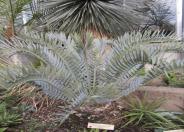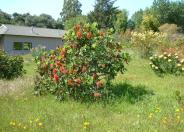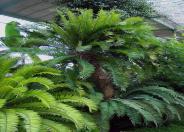
Common name:Eastern Cape blue cycad
Botanical name:Encephalartos horridus
Encephalartos horridus, commonly called ferocious blue cycad (also eastern cape blue cycad), is a slow-growing, small to medium-sized, evergreen blue cycad that is native to rocky outcroppings, slopes and ridges in Eastern Cape Province, South Africa. It is a small, palm-like, tropical plant that features pinnate, spiny, blue-green leaves and large seed cones. From thick tuberous roots, each mature plant forms a short, stocky trunk, all or a part of which is often subterranean, with pinnate, recurving leaves rising on stems to 2-3' tall in a dense terminal crown. Hard, lanceolate, spine-tipped leaflets emerge silver blue, but typically age over time to blue green or green. Leaflets give rise to the specific epithet (horridus from Latin meaning prickly). This cycad is dioecious (separate male and female plants). Red-brown flowering cones (to 16" long) appear in summer. Male cones are cylindrical and female cones are oval. Winter hardy to USDA Zones 10-12 where it can be grown outdoors in deep, organically rich, fertile, dry to medium moisture, well-drained soils in full sun. Full sun is needed for best blue leaf color. Best performance occurs in soils with even moisture, but avoid overwatering. Tolerates drought. Tolerates an occasional light frost. May be propagated from suckers. Plants grown by seed take several years to mature. North of USDA Zone 10, plants may be grown in containers must be overwintered indoors in cool, bright, sunny locations. Uniquely attractive leaves provide excellent accent to gardens in frost free areas. Good mixed with succulent plants. Grow in conservatories, warm greenhouses or as indoor potted plants north of USDA Zone 10. Excellent trunkless indoor container plant when young. Plants may be difficult to obtain in commerce. Eventually reaches 3' tall and 4' wide.

Common name:Natal bottlebrush
Botanical name:Greyia sutherlandii
Greyia sutherlandii is a large shrub or small tree, 10-20 ft high. It is deciduous and in late autumn the leaves turn shades of bright red. Young trees are compact and old trees do not grow tall but they spread and have rough, dark trunks. The leaves are simple, alternate, rather leathery, slightly lobed and coarsely toothed. The leaf surface is hairless and minutely glandular. The leaf veins radiate from the base. The leaf stalk is long and straight. The beautiful flowers are red, with oblong petals and long protruding stamens. The showy flowers open in closely packed racemes at the tips of the branches and bloom at the end of winter and early spring. The fruit is a pale brown, cone-shaped, cylindrical capsule, of 20 mm long. It splits in 4 or 5 parts when ripe to release seeds from October to December. The wood is pale pink and generally light and soft.

Common name:Prickly Cycad; Bread Tree
Botanical name:Encephalartos altensteinii
Encephalartos altensteinii, commonly called prickly cycad, is a very slow-growing, evergreen tree with palm-like foliage that is native to South Africa (East Cape Province). In the early years, this tree appears trunkless, producing stiff, pinnate, palm-like leaves with spiny bright green leaflets. Leaves are whorled into a dense upright crown. Over time, a stout trunk begins to develop, eventually rising to 12-16’ tall. Trunks often tend to recline once they reach about 10’ tall. On mature trees, leaves in the terminal crown will grow to as much as 9’ long. This is a dioecious tree that reproduces by seed cones. Large yellowish-green cones on female trees grow to 22” long, somewhat resembling a pineapple. Cones on male trees are cylindrical and smaller. Leaflets usually have prickles, hence the common name of prickly cycad. Another common name for this tree is bread tree. Winter hardy to USDA Zones 10-12 where it can be grown outdoors in medium moisture, well-drained loams in full sun to part shade. Tolerates shade. Best performance occurs in moist soils with regular irrigation, but avoid overwatering. Tolerates drought. Also tolerates occasional light frost. Ornamental specimen for frost free areas. Grow in conservatories, warm greenhouses or as indoor potted plants north of USDA Zone 10. Excellent trunkless indoor container plant when young.
Designer: UC Berkeley
Photographer: Vicki Anderson
Incorporate compost 6" into your soil to retain water, reduce compaction, feed earthworms, and provide valuable nutrients to your plants.
Drip and other smart irrigation delivers water directly to roots, allowing no excess water for weeds.